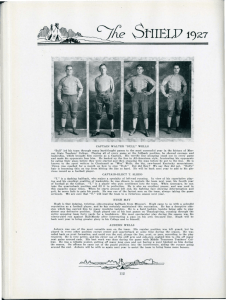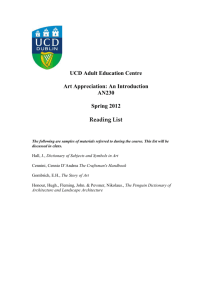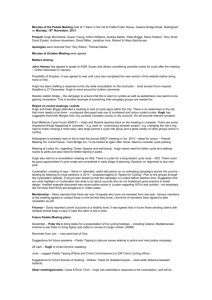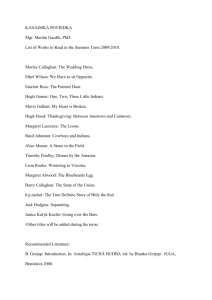. IN MEMORIAM: Conel Hugh O'Donel Alexander SECRET
advertisement
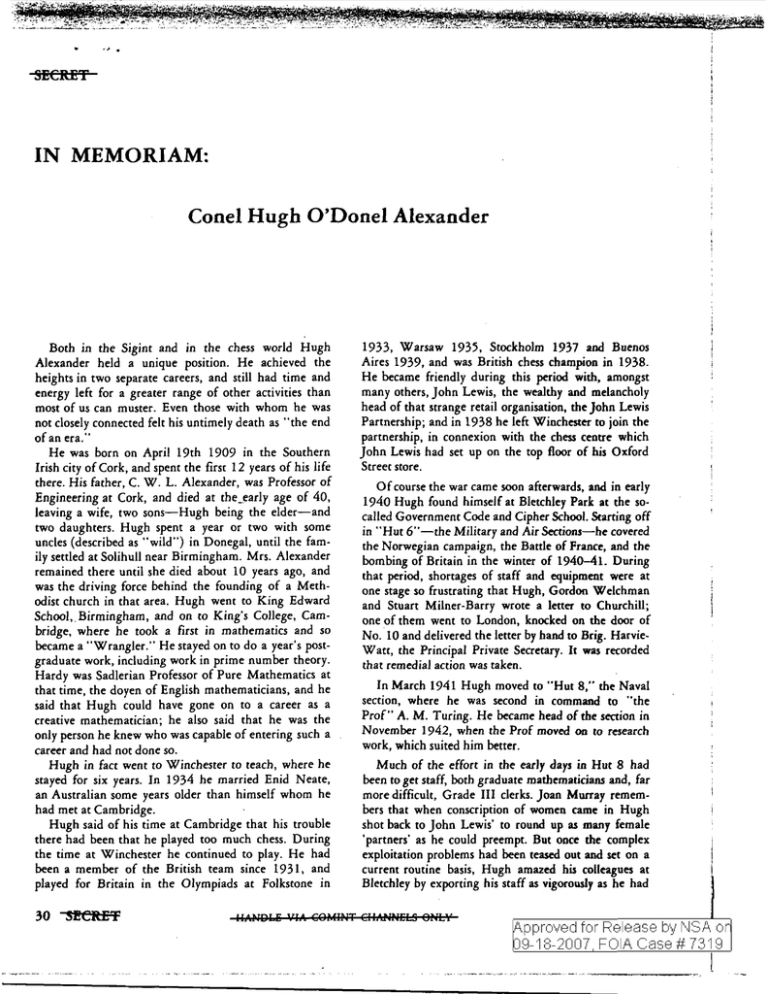
.,.
.
SECRET
IN MEMORIAM:
Conel Hugh O'Donel Alexander
Both in the Sigint and in the chess world Hugh
Alexander held a unique position. He achieved the
heights in two separate careers, and still had time and
energy left for a greater range of other activities than
most of us can muster. Even those with whom he was
not closely connected felt his untimely death as "the end
of an era."
He was born on April 19th 1909 in the Southern
Irish city of Cork, and spent the first 12 years of his life
there. His father, C. W. L. Alexander, was Professor of
Engineering at Cork, and died at the __early age of 40,
leaving a wife, two sons-Hugh being the elder-and
two daughters. Hugh spent a year or two with some
uncles (described as "wild") in Donegal, until the family settled at Solihull near Birmingham. Mrs. Alexander
remained there until she died about 10 years ago, and
was the driving force behind the founding of a Methodist church in that area. Hugh went to King Edward
School,_ Birmingham, and on to King's College, Cambridge, where he took a first in mathematics and so
became a "Wrangler." He stayed on to do a year's postgraduate work, including work in prime number theory.
Hardy was Sadlerian Professor of Pure Mathematics at
that time, the doyen of English mathematicians, and he
said that Hugh could have gone on to a career as a
creative mathematician; he also said that he was the
only person he knew who was capable of entering such a
career and had not done so.
Hugh in fact went to Winchester to teach, where he
stayed for six years. In 1934 he married Enid Neate,
an Australian some years older than himself whom he
had met at Cambridge.
Hugh said of his time at Cambridge that his trouble
there had been that he played too much chess. During
the time at Winchester he continued to play. He had
been a member of the British team since 1931, and
played for Britain In the Olympiads at Folkstone in
30
S!CIt£'F
IIA~lQb);
1933, Warsaw 1935, Stockholm 1937 and Buenos
Aires 1939, and was British chess champion in 1938.
He became friendly during this period with, amongst
many others, John Lewis, the wealthy and melancholy
head of that strange retail organisation, the John Lewis
Partnership; and in 1938 he left Winchester to join the
partnership, in connexion with the chess centre which
John Lewis had set up on the top floor of his Oxford
Street store.
Of course the war came soon afterwards, and in early
1940 Hugh found himself at Bletehley Park at the socalled Government Code and Cipher School.Starting off
in ..Hut 6" -the Military and Air Sections-he covered
the Norwegian campaign, the Battle of France, and the
bombing of Britain in the winter of 1940-41. During
that period, shortages of staff and equipment were at
one stage so frustrating that Hugh, Gordon Welchman
and Stuart Milner-Barry wrote a letter to Churchill;
one of them went to London, knocked on the door of
No. 10 and delivered the letter by hand to Brig. HarvieWatt, the Principal Private Secretary. It was recorded
that remedial action was taken.
In March 1941 Hugh moved to "Hut 8," the Naval
section, where he was second in command to "the
Prof" A. M. Turing. He became head of the section in
November 1942, when the Prof moved on to research
work, which suited him better.
Much of the effort in the early days in Hut 8 had
been to get staff, both graduate mathematicians and, far
more difficult, Grade III clerks. Joan Murray remembers that when conscription of women came in Hugh
shot back to John Lewis' to round up as many female
'partners' as he could preempt. But once the complex
exploitation problems had been teased out and set on a
current routine basis, Hugh amazed his colleagues at
Bletchley by exporting his staff as vigorously as he had
VIA €QlofInT EIIMmELS aNl...
.
s .
SECRET
imported them-the more likely you were to help the
war effort elsewhere, the sooner you left Hut 8. Hugh
himself moved out-effectively towards the end of
1943-and became head of one of the japanese Naval
High-grade sections. This was a less satisfying job than
the earlier one, since the primary centres were elsewhere-Washington and Pearl Harbor, and to a lesser
extent, Melbourne and Colombo.
As soon as the war ended Hugh returned to john
Lewis', to be deputy head of the Research Unit, second
to Welchman. But he did not really merge into a job
that involved a black jacket and striped trousers, and a
year later he was back at GC&CS, now called GCHQ
and located at Eastcote, on the NW edge of the London
suburban sprawl. He started off in 'R department'-the
ancestor of HR, but then a separate division. The
original idea, which lapsed, was that he would become
the first Director of the Australian centre. He in fact
moved to head the Coleridge party, and soon moved
again, this time upwards to be head of the Russian
crypt branch, H5. In June 1949 Josh Cooper left H to
join the Directorate and Hugh replaced him as head of
the division, the post he held for the next 21 XI years.
The story of these years is the story of H Division,
and cannot be attempted, even in outline, here. The
problems were both organisational and technical, and
in both he contributed decisively. Perhaps on the
organisational side the biggest monument is H Division
itself-the survival of a large technique-oriented production unit side by side with the j, K, and later V,
task-oriented units. The problem is an old one-should
specialists be managed by the professional organisation
or by the organisation to whom they supply their services? The answer is by both: they should answer professionally to the former (i.e., H) and operationally to the
latter (i.e., j or K). This theme was worked out in
several different ways. Sometimes H men sat in J or K
areas, sometimes vice versa; sometimes the arrangements were more complex. But in all cases both professional and operational requirements were met. The
system which he developed worked harmoniously in his
time and has survived his departure.
On the technical side Hugh put in more individual
work than any head of division has a right to; but his
most important contribution was by encouragement and
suggestion, by clear-cut views which simplified the
problem, by going around sections, looking over
people's shoulders, asking questions, having ideas; and
more than anything else by sheer infectious enthusiasm.
Although Hugh was always vastly pleased when one of
his suggestions worked, he claimed no proprietary
interests, and the actual technical papers that carry his
l
name during this period are few. All are readable. His
roots were in the manual and semi-manual cryptanalysis
t"!/dq'BLE VIA C8MUJT
of pre-general-purpose-computer days, but he was on the
look-out for totally new methods of reading enciphered
messages. Two of the most important new kinds of
cryptanalysis, now practised both at GCHQ and NSA,
began, not with Hugh, but because Hugh pushed them.
In general, Hugh was not mechanically minded. He
regarded even driving a car as technically beyond his
reach, and never learnt to program. But he understood
clearly enough what computers Can do for cryptanalysis,
and was the loudest propagandist at GCHQ for huge
increases in our computer power_
On the chess side Hugh played for Britain until 1958,
won the British championship again in 1956, and was
non-playing captain of the British team 1964-72. Had
he chosen to take the game up professionally there
seems to be little doubt that he would have been of
grandmaster class, and possibly have gone even further.
At Hastings in 1938 he tied with Keres and came ahead
of Fine and Flohr, and in 1953 tied with Bronstein
after beating him in a game of over 100 moves; in his
time he also beat Botwinnik (in the famous 1946
Anglo-Soviet radio match), Gligoric, Pachman and
Szabo. It is certainly significant that in spite of all this
he chose to live at Eastcore and Cheltenham and do
Sigint. Recently he went in more for correspondence
chess, and was doing well in several games in the world
team finals when he died-a bit of unfinished business
which would have annoyed him a lot. Before he retired
he was writing regularly about chess, particularly for his
column in the Sunday Times, and bad already written
various books:
Chess. 1937. (A beginner's guide.)
Alekhine '.1 Best Games ofCbess. Vol. Ill. 1946. .
Learn Chess: A New Way Few All. (With T. J.
Beach.) Two vols. 1963.
After retirement he hesitantly declined an invitation to work at IDA(CRD), and the books began to
pour out:
Spas.sky and Fischer; The World Cbes« Chtlmpionship, 1972.
.Ii Book a/Chess. 1973 (getit, even if you don't play
the game).
The Penguin Book of Chess Positions. 1973. (Well
worth 30p, and according to the reviewer, would have
been the year's best chess book at any price.)
Alexander on Chess. 1974. (a revision of the 1937
book).
1 Sec "The Factor Method" (N_I Crypllmlllyti, SllldieJ Vol. I
pages 12-64. A child's, and adult's, guide to scoring the evidence),
"A New Hagelin Statistical Method" (1946-7) and "Type J Callsign Keys" (HR/Tceh. A/262 dated 11.9.68).
€IM~JI'JiJ..i O~L¥
-SECltEr 31
----------------------.. . . . ......,..-~----.-.,.--...-------,.-..'"'_""'7 .
}
i
,~~;;#rUhi:e'4'*i:ifitg~{"':'M5,iF¥):L;b&,...wY;iI.y~df-'i¥d;;.t wtMi't'._:..&.e-> ¥P~~;-'_~'<"C··~·:'""'-'M-·~ --n--bbi:.teEiitIi<Y'·w' .:.re"'..... ·- iii;,;"'-aLo' ,c_ 5·
;,a,.-e,.· -,
I
Unfinished was a history of British chess since 1900. He
said he had earned more per year by writing over these
two years than he had in his last year of regular employment.
That is an outline of the life-and it does not mention the subsidiary outlets, like stamps, and bridge, and
croquet. But the outline does not explain the wide
range of his influence, or why his loss has been felt so
deeply. The Memorial Service was held at St. Luke's
Cheltenham on March 15th, and his lifelong friend
Stuart Milner-Barry gave the address. Milner-Barry's
opening words perhaps summed it up as well as any
words will. They were to the effect that he had known
Hugh since they were at school, and had seen him the
weekend before the end, and that Hugh had not
changed during this period. He had retained an almost
boyish zest throughout life-was always totally absorbed
in what he was telling you or, more often than not, in
what you were telling him.
The end came on Friday February 15th. He was 64,
and is survived by his widow, two sons and three grandchildren. There was a two-column notice in the Times
by Harry Golombek on the following day. A few days
later there was a further notice by Stuart Milner-Barry.
Your present writer can do no better than to conclude by
quoting from this moving tribute:
., After his retirement he intended to devote himself
to writing about chess, but he had only just embarked
on the Fischer Spassky book when he became desperately ill. Perhaps only Hugh himself thought that he
could recover, but through the skill of his doctors and
SEellEI
?tr· -&. .~
I
~~;.
32
I
fortified by the sympathy and devotion of his friends
(which greatly astonished him, for he had little idea of
the affection and admiration which he inspired) he not
only did so, but from his sick room completed against
time the whole of this brilliant work-a remarkable
example of the tenacity, resourcefulness and sheer
stamina which made him so formidable an opponent,
especially in unfavourable positions.
"For a further 18 months he enjoyed great happiness
and contentment at his new home in Cheltenham. He
wrote two more splendid books, and was well on the
way with a third; and he made at gruelling cost a major
personal contribution to the organisation of the
European Team Tournament at Bath in July. When a
short while ago he was again stricken down, his illness
was mercifully brief. He continued working to the end,
he maintained as always the liveliest interest in the
doings of his family and friends, and he never realised
that this was a game that even he could not save.
"One could have wished for nothing else but that
vivid and vigorous presence, that quick, clear and
energetic mind, the passion for intellectual argument,
the practical kindness and spontaneous understanding
with the young-all this will be sadly missed. To have
been so close a friend for 50 years is indeed good
fortune."
-Hugh Denham
Mr. Denham is a senior official at GCHQ.
I"IJ'd4f)Lf .. ItI: eOMIf4'f' eUtI:I4Ifl!U OI4Li
~ 74-83-23198

